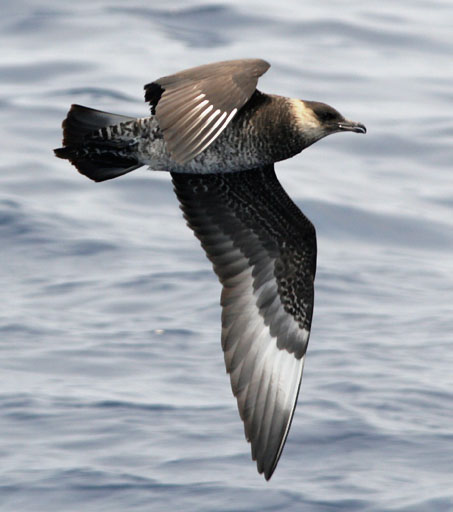- Skua
Taxobox
name = Skuas

image_caption = "Pomarine Skua "
image_width = 250px
regnum =Animal ia
phylum = Chordata
classis = Aves
ordo =Charadriiformes
familia = Stercorariidae
familia_authority = Gray, 1871
genus = "Stercorarius"
genus_authority = Brisson, 1760
subdivision_ranks =Species
subdivision = See TextSkuas are
seabird s in the family Stercorariidae. The three smaller skuas are called jaegers in North America.The name "skua" comes from Faroese "skúgvur" IPA2|ˈskɪkvʊɹ ("Stercorarius skua"), and the island of
Skúvoy is renowned for its colony of that bird. "Jaeger" is derived from the German word "Jäger", meaning "hunter".Skuas nest on the ground in temperate and Arctic regions and are long-distance migrants.
Biology and habits
Outside the breeding season, skuas take fish, offal and carrion. Many are partial kleptoparasites, chasing gulls, terns and other seabirds to steal their catches; the larger species also regularly kill and eat adult birds, up to the size of
Great Black-backed Gull s. On the breeding grounds they commonly eatlemming s, and the eggs and young of other birdscite book |editor=Forshaw, Joseph|author= Harrison, Colin J.O.|year=1991|title=Encyclopaedia of Animals: Birds|publisher= Merehurst Press|location=London|pages= 109|isbn= 1-85391-186-0] .They are in general medium to large
bird s, typically with grey or brown plumage, often with white markings on the wings. They have longish bills with a hooked tip, and webbed feet with sharp claws. They look like large dark gulls, but have a fleshy cere above the upper mandible. They are strong, acrobatic fliers.Taxonomy
Skuas are related to
gull s,wader s,auk s andskimmer s. In the three smaller species (all Holarctic), breeding adults have the two central tail feathers obviously elongated and at least some adults have white on the underparts and pale yellow on the neck, characteristics that the larger species (all native to the Southern Hemisphere except for the Great Skua) do not share. Therefore the skuas are often split into two genera with only the smaller species retained in "Stercorarius", and the large species placed in "Catharacta". However, there is no genetic basis for this separationFact|date=February 2007. The Pomarine and Great Skuas'mitochondrial DNA (which is inherited from the mother only) is in fact more closely related to each other than it is to either Arctic or Long-tailed Skuas, or to the Southern Hemisphere speciesFact|date=February 2007. Thus, hybridization must have played a considerable role in the evolution of the diversity of Northern Hemisphere skuas.pecies
*
Long-tailed Skua or Long-tailed Jaeger, "Stercorarius longicaudus"
*Arctic Skua or Parasitic Jaeger, "Stercorarius parasiticus"
*Pomarine Skua or Pomarine Jaeger, "Stercorarius pomarinus"
*Chilean Skua , "Stercorarius chilensis"
*South Polar Skua , "Stercorarius maccormicki"
*Brown Skua , "Stercorarius antarctica"
*Great Skua "Stercorarius skua"References
* Harrison, Peter "Seabirds: An Identification Guide" ISBN 0-7470-1410-8
External links
* [http://ibc.hbw.com/ibc/phtml/familia.phtml?idFamilia=65 Skua videos] on the Internet Bird Collection
Wikimedia Foundation. 2010.
